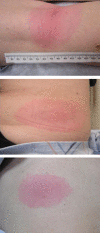Misdiagnosis of early Lyme disease as the summer flu
- PMID: 22053255
- PMCID: PMC3206512
- DOI: 10.4081/or.2011.e14
Misdiagnosis of early Lyme disease as the summer flu
Abstract
Lyme disease is often identified by the hallmark erythema migrans rash, but not all early cases present with a rash. In other cases the rash may be unseen or unrecognized by a physician. In these situations, Lyme disease is difficult to diagnose because it masquerades as a non-specific viral-like illness. The seasonal peak of Lyme disease ranging from May through September overlaps with that of viral illnesses such as enteroviral infections, West Nile virus, and in rare years such as 2009, early influenza season. We present a case of a patient with Lyme disease who was initially misdiagnosed with influenza A during the summer of 2009. Because of the diagnostic importance of recognizing the erythema migrans rash, physicians in endemic regions should always ask about new rashes or skin lesions and perform a thorough physical examination when patients present over the summer with viral-like symptoms. Even when no rash is evident, Lyme disease should be considered if these symptoms persist or worsen without a specific diagnosis.
Keywords: Lyme disease; diagnosis; summer flu; viral-like illness.
Figures


References
-
- Bacon RM, Kugeler KJ, Mead PS. Surveillance for Lyme disease--United States, 1992–2006. MMWR Surveill Summ. 2008;57:1–9. - PubMed
-
- Meek JI, Roberts CL, Smith EV, Jr, Cartter ML. Underreporting of Lyme disease by Connecticut physicians, 1992. J Public Health Manag Pract. 1996;2:61–5. - PubMed
-
- Coyle BS, Strickland GT, Liang YY, et al. The public health impact of Lyme disease in Maryland. J Infect Dis. 1996;173:1260–2. - PubMed
-
- Piesman J, Mather TN, Dammin GJ, et al. Seasonal variation of transmission risk of Lyme disease and human babesiosis. Am J Epidemiol. 1987;126:1187–9. - PubMed
-
- Tibbles CD, Edlow JA. Does this patient have erythema migrans? JAMA. 2007;297:2617–27. - PubMed
LinkOut - more resources
Full Text Sources
